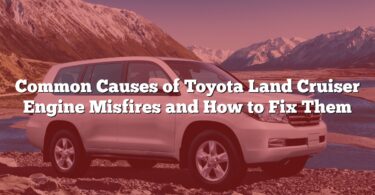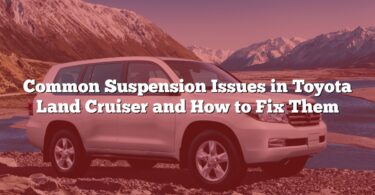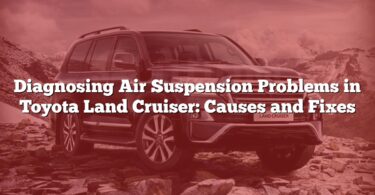Experiencing a shaking engine in your Toyota Land Cruiser can be frustrating and even concerning. Whether it happens at idle, low speeds, or on the highway, the issue could stem from a range of mechanical, electrical, or maintenance-related problems. This guide breaks down the possible causes and provides clear, actionable solutions to help you get your vehicle running smoothly again. Stay ahead of potential issues and ensure your Land Cruiser performs at its best with these practical insights.
Problems and Their Solutions for Toyota Land Cruiser Engine Shaking
| N° | Problem/Cause | Solution |
|---|---|---|
| 1 | Misfiring cylinders | Inspect and replace faulty components like spark plugs or coils. |
| 2 | Faulty spark plugs | Replace spark plugs with recommended specifications. |
| 3 | Worn ignition coils | Replace worn ignition coils. |
| 4 | Compression loss | Perform a compression test and repair cylinder head or piston rings as needed. |
| 5 | Engine timing issues | Adjust or replace the timing belt/chain. |
| 6 | Clogged air filters | Replace the air filter. |
| 7 | Clogged fuel filters | Replace the fuel filter. |
| 8 | Faulty fuel pump | Inspect and replace the fuel pump. |
| 9 | Incorrect air-fuel mixture | Diagnose with an OBD-II scanner and adjust the air-fuel mixture. |
| 10 | Contaminated fuel | Drain and refill the fuel tank with clean fuel. |
| 11 | Faulty mass air flow (MAF) sensor | Clean or replace the MAF sensor. |
| 12 | Vacuum leaks | Identify and seal vacuum leaks in hoses or connections. |
| 13 | Exhaust system blockage | Inspect and clear or replace the blocked exhaust components. |
| 14 | Faulty oxygen sensor | Replace the oxygen sensor. |
| 15 | Damaged engine mounts | Replace worn engine mounts. |
| 16 | Imbalanced or worn crankshaft | Inspect the crankshaft and repair or replace as necessary. |
| 17 | Faulty timing belt or chain | Replace the timing belt/chain and inspect tensioners. |
| 18 | Valve train issues | Adjust or repair valves, lifters, or camshafts. |
| 19 | Low engine oil pressure | Check oil levels, replace the oil pump, or address internal engine wear. |
| 20 | Faulty injectors | Clean or replace fuel injectors. |
| 21 | Loose or misaligned wheels | Tighten or align the wheels. |
| 22 | Imbalanced tires | Balance the tires. |
| 23 | Damaged rims | Repair or replace damaged rims. |
| 24 | Uneven or rapid tire wear | Rotate tires and ensure proper alignment. |
| 25 | Suspension component wear | Inspect and replace worn suspension parts. |
| 26 | Worn-out shocks or struts | Replace shocks or struts. |
| 27 | Faulty wheel bearings | Replace worn or damaged wheel bearings. |
| 28 | Loose or damaged lug nuts | Tighten or replace lug nuts. |
| 29 | Faulty axles | Inspect and replace damaged axles. |
| 30 | Steering misalignment | Perform a wheel alignment. |
| 31 | Loose suspension or steering components | Tighten or replace loose components. |
| 32 | Low or excessively high tire pressure | Inflate tires to manufacturer-recommended pressure. |
| 33 | Electrical wiring issues | Inspect and repair faulty wiring or connections. |
| 34 | Software or ECU glitches | Update or reset the ECU. |
| 35 | Use of low-quality parts | Replace with high-quality, OEM-approved parts. |
| 36 | Regular wear and tear | Perform regular maintenance and replace worn components. |
Detailed Guide: 36 Problems and Their Solutions for Toyota Land Cruiser Engine Shaking
1. Misfiring Cylinders
Reason:
- Faulty spark plugs or ignition coils may prevent proper combustion.
- Incorrect air-fuel mixture can disrupt cylinder firing.
- Damaged injectors may fail to supply fuel evenly.
Solution:
- Replace faulty spark plugs or ignition coils.
- Use an OBD-II scanner to diagnose and correct air-fuel ratio issues.
- Test injectors and clean or replace them as needed.
2. Faulty Spark Plugs
Reason:
- Worn-out spark plugs fail to ignite fuel efficiently.
- Incorrect spark plug gap disrupts combustion.
Solution:
- Replace all spark plugs with ones matching the manufacturer’s specifications.
- Check and adjust the spark plug gap to the correct measurements.
3. Worn Ignition Coils
Reason:
- Coils degrade over time, leading to inconsistent spark delivery.
Solution:
- Test the ignition coils using a multimeter and replace the defective ones.
4. Compression Loss
Reason:
- Damaged piston rings or cylinder walls can cause low compression.
- Leaking head gaskets may allow compression to escape.
Solution:
- Perform a compression test on all cylinders.
- Replace piston rings, head gaskets, or repair cylinder walls as needed.
5. Engine Timing Issues
Reason:
- Worn or misaligned timing belts/chains disrupt engine synchronization.
Solution:
- Inspect the timing belt or chain for wear.
- Replace the belt/chain and adjust timing according to the service manual.
6. Clogged Air Filters
Reason:
- Restricted airflow reduces engine performance and causes vibration.
Solution:
- Replace the air filter with a new one. Clean the surrounding intake housing.
7. Clogged Fuel Filters
Reason:
- Fuel flow is restricted, leading to uneven engine operation.
Solution:
- Replace the fuel filter and ensure proper installation.
8. Faulty Fuel Pump
Reason:
- A malfunctioning fuel pump fails to supply the engine with adequate fuel pressure.
Solution:
- Test fuel pressure with a gauge.
- Replace the fuel pump if it cannot meet the required pressure.
9. Incorrect Air-Fuel Mixture
Reason:
- Faulty sensors or incorrect ECU settings cause imbalance in air and fuel proportions.
Solution:
- Diagnose the issue using an OBD-II scanner.
- Replace defective sensors or adjust ECU parameters.
10. Contaminated Fuel
Reason:
- Water or debris in fuel affects combustion efficiency.
Solution:
- Drain the fuel tank.
- Refill with high-quality, clean fuel.
11. Faulty Mass Air Flow (MAF) Sensor
Reason:
- A dirty or malfunctioning MAF sensor provides incorrect air measurement data.
Solution:
- Clean the MAF sensor using an appropriate cleaner.
- Replace the sensor if cleaning does not resolve the issue.
12. Vacuum Leaks
Reason:
- Cracked hoses or loose connections cause air leaks, affecting engine performance.
Solution:
- Inspect all vacuum hoses for damage or disconnection.
- Replace damaged hoses and ensure all connections are secure.
13. Exhaust System Blockage
Reason:
- A blocked catalytic converter or muffler causes backpressure and engine strain.
Solution:
- Inspect the exhaust system for blockages.
- Clean or replace clogged components.
14. Faulty Oxygen Sensor
Reason:
- A malfunctioning sensor provides incorrect data, disrupting the air-fuel mixture.
Solution:
- Replace the oxygen sensor with an OEM-compatible unit.
15. Damaged Engine Mounts
Reason:
- Worn rubber mounts fail to absorb engine vibrations.
Solution:
- Inspect engine mounts for wear or cracks.
- Replace the mounts with high-quality replacements.
16. Imbalanced or Worn Crankshaft
Reason:
- Crankshaft wear or imbalance causes uneven engine rotation.
Solution:
- Balance the crankshaft or replace it if necessary.
17. Faulty Timing Belt or Chain
Reason:
- Timing components wear out over time, affecting synchronization.
Solution:
- Replace the belt or chain and inspect tensioners for proper function.
18. Valve Train Issues
Reason:
- Bent valves or worn lifters disrupt the combustion cycle.
Solution:
- Inspect and repair or replace valves, lifters, and camshafts as needed.
19. Low Engine Oil Pressure
Reason:
- Insufficient lubrication causes internal engine wear.
Solution:
- Check oil levels and top off if needed.
- Replace the oil pump or address underlying wear issues.
20. Faulty Injectors
Reason:
- Dirty or malfunctioning injectors fail to deliver fuel evenly.
Solution:
- Clean or replace the injectors. Test their flow rates for consistency.
21. Loose or Misaligned Wheels
Reason:
- Improperly secured wheels lead to vibrations.
Solution:
- Tighten the lug nuts and align the wheels.
22. Imbalanced Tires
Reason:
- Uneven weight distribution causes vibrations.
Solution:
- Balance all tires and ensure even weight distribution.
23. Damaged Rims
Reason:
- Bent rims cause uneven rotation.
Solution:
- Repair or replace the damaged rims.
24. Uneven or Rapid Tire Wear
Reason:
- Misaligned wheels or improper tire maintenance lead to uneven tread wear.
Solution:
- Rotate the tires regularly, typically every 6,000-8,000 miles.
- Ensure proper wheel alignment and check for any suspension-related issues.
25. Suspension Component Wear
Reason:
- Worn bushings, control arms, or ball joints affect stability and cause vibrations.
Solution:
- Inspect all suspension components for wear.
- Replace damaged or worn parts, such as bushings or control arms.
26. Worn-Out Shocks or Struts
Reason:
- Failing shocks or struts reduce damping efficiency, leading to instability.
Solution:
- Replace worn-out shocks or struts with OEM-approved parts.
- Check for additional suspension damage during the replacement process.
27. Faulty Wheel Bearings
Reason:
- Damaged or worn wheel bearings disrupt smooth wheel rotation.
Solution:
- Inspect wheel bearings for play or noise.
- Replace faulty bearings with new ones for improved stability.
28. Loose or Damaged Lug Nuts
Reason:
- Improperly tightened or damaged lug nuts compromise wheel security.
Solution:
- Tighten lug nuts to manufacturer-specified torque.
- Replace damaged lug nuts and inspect the wheel hub for issues.
29. Faulty Axles
Reason:
- Bent or damaged axles cause uneven power transfer and vibrations.
Solution:
- Inspect axles for physical damage or wear.
- Replace faulty axles and ensure proper alignment of drivetrain components.
30. Steering Misalignment
Reason:
- Misaligned wheels affect steering dynamics and cause vibrations.
Solution:
- Perform a full wheel alignment.
- Regularly check alignment, especially after hitting potholes or curbs.
31. Loose Suspension or Steering Components
Reason:
- Worn or loose tie rods, sway bars, or bushings lead to instability.
Solution:
- Inspect and tighten loose components.
- Replace worn suspension or steering parts as needed.
32. Low or Excessively High Tire Pressure
Reason:
- Underinflated tires increase resistance, while overinflated tires reduce traction, causing vibrations.
Solution:
- Adjust tire pressure to the manufacturer’s recommended levels.
- Check pressure regularly and monitor for leaks or punctures.
33. Electrical Wiring Issues
Reason:
- Loose or damaged wiring can disrupt sensor signals and engine performance.
Solution:
- Inspect all engine wiring for frays, loose connections, or corrosion.
- Repair or replace any faulty wires and secure all connectors.
34. Software or ECU Glitches
Reason:
- Outdated or corrupted ECU software may mismanage engine operations.
Solution:
- Update the ECU software using the latest firmware from the manufacturer.
- Reset the ECU if required and test for improvements.
35. Use of Low-Quality Parts
Reason:
- Subpar components fail prematurely, causing vibrations and instability.
Solution:
- Replace with high-quality, OEM-approved parts.
- Always source components from reputable suppliers.
36. Regular Wear and Tear
Reason:
- Continuous use of the vehicle naturally leads to component degradation.
Solution:
- Perform regular maintenance, including oil changes, filter replacements, and component inspections.
- Adhere to the manufacturer’s service schedule for optimal vehicle longevity.
Preventing Future Issues
To avoid engine shaking and ensure the long-term health of your Toyota Land Cruiser, follow these preventive measures step by step:
- Perform Regular Maintenance:
- Schedule routine oil changes, filter replacements, and inspections as recommended by the manufacturer.
- Keep track of service intervals using the owner’s manual.
- Inspect Tires Frequently:
- Check tire pressure monthly and inflate to manufacturer-recommended levels.
- Rotate tires every 6,000-8,000 miles to ensure even wear.
- Balance and align wheels annually or as needed.
- Use Quality Parts:
- Always replace components with high-quality, OEM-approved parts to ensure reliability and compatibility.
- Avoid using low-grade or non-recommended replacements.
- Monitor Fuel Quality:
- Refuel only at reputable gas stations to minimize the risk of contaminated fuel.
- Consider using fuel system cleaners periodically to keep injectors and lines clean.
- Inspect the Engine and Sensors:
- Check spark plugs, ignition coils, and sensors during regular servicing.
- Use an OBD-II scanner to identify potential issues early.
- Maintain the Suspension and Steering:
- Inspect suspension components such as shocks, struts, and bushings for wear.
- Address any unusual noises or handling issues promptly.
- Prevent Overloading:
- Avoid exceeding the vehicle’s weight limit, as this stresses the suspension and drivetrain.
- Distribute cargo evenly to maintain balance.
- Address Issues Promptly:
- If you notice vibrations or any unusual behavior, address them immediately to prevent more severe damage.
- Consult a professional mechanic for diagnostics if the issue is beyond your expertise.
- Keep the Vehicle Clean:
- Regularly wash and clean the vehicle to prevent buildup that can affect the sensors, engine, or other components.
- Drive Responsibly:
- Avoid aggressive driving habits, such as hard braking, rapid acceleration, or sharp cornering.
- Steer clear of potholes and rough roads whenever possible.
By following these steps consistently, you can reduce the likelihood of future problems and ensure a smooth driving experience with your Toyota Land Cruiser.







